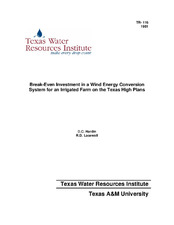| dc.description.abstract | The purpose of this study was to quantify the benefits of using a wind energy system for irrigation. The value of wind energy was estimated on both a static basis (where the annual value of wind power was assumed to be constant over the life of the machine) and on a temporal basis (where the annual value of wind power was estimated recursively).
The model for static analysis contained two components which were applied consecutively. The first was a linear programming (LP) model for the High Plains region. Production activities were included which allowed both optimal and non-optimal timing of post-plant irrigations, giving the producer added flexibility in the employment of limiting water resources. The optimal irrigation schedule determined by the LP solution was used as input to the second component. A simulation model matched stochastically generated estimates of wind power availability with irrigation fuel requirements (derived from the profit maximizing irrigation schedule) by three-hour time periods throughout a year.
For the temporal analysis, a Fortran subroutine was added to the LP model to operate the model recursively over the life of the wind system and to account for the annual decline of the aquifer. Both fixed and variable costs were included. The basic LP model was applied to develop the benchmark case (i.e., without wind power). The farm operation with wind power was analyzed by applying the LP model with the monthly expectations of wind-generated electricity added.
Two wind machines were analyzed, with rate outputs of 40 to 60 kilowatts (KW). Each was applied to the Northern and Southern Texas High Plains over a range of land and water resource situations. Breakeven investment was estimated at discount rates of three, five and ten percent.
Cropping patterns on the Southern High Plains were dominated by irrigated cotton and were insensitive to changes in crop or electricity prices. On the Northern High Plains, irrigated corn and grain sorghum were the major crops, with acreage reverting to dryland wheat at the higher electricity prices. The cropping patterns in this area were impacted heavily by labor restrictions. Consideration of wind power had little effect in determining optimal cropping patterns.
When wind power was applied to an irrigated farm on a static basis, the set of crop prices applied had little effect on the annual value of a wind system. Value of wind power was increased, but by smaller proportions than associated increases in the price of electricity. Each machine size had a greater value when operated on the larger of the two applicable land units (100 acres for the 40 KW machine and 144 acres for the 60 KW system). The 60 KW system was also tested on the 100 acre unit but returned less per KW than the 40 KW system.
Available wind power in the temporal analysis was less than in the static analysis, thus temporal estimates of wind system value should be regarded as conservative. On the Southern High Plains, break-even investment was decreased slightly from the static analysis. However, in some situations on the Northern High Plains, break-even investment increased. This indicates that the value of wind power could increase as the aquifer declines in some situations. Break-even investment increased by up to 80 percent when the price of electricity was increased by $.005 per KWH per year. The most significant effect of wind power was that it allowed the maintenance of irrigation levels which, without wind power, had been made uneconomical.
These results indicate that, at least in the future when wind system costs decrease and stabilize, wind-assisted irrigation could be an economically viable alternative for Texas High Plains producers. The results are limited by the need for future research regarding the effect of irrigation timing on crop yield as well as some of the long-term characteristics of wind system operation, such as durability and the requirements and costs for system repairs and maintenance. | en |


